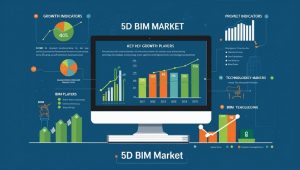The North American 5D Building Information Modeling (BIM) market is witnessing transformative growth, largely propelled by the integration of Artificial Intelligence (AI) and cloud computing technologies. These innovations are reshaping how construction projects are planned, managed, and executed by adding new dimensions of intelligence and connectivity to traditional BIM processes. The synergy between AI and cloud platforms is enhancing the capabilities of 5D BIM— which combines 3D modeling with time (4D) and cost (5D) data—leading to smarter decision-making, improved collaboration, and greater project efficiency across the region.
AI’s impact on the 5D BIM market is profound. Machine learning algorithms analyze historical project data to optimize cost estimation, schedule forecasting, and risk management, reducing uncertainties and enhancing accuracy. AI-powered automation accelerates clash detection, design validation, and resource allocation, minimizing costly errors and rework. Furthermore, AI-driven predictive analytics enable stakeholders to anticipate potential delays and budget overruns, allowing proactive mitigation strategies that keep projects on track and within budget.
Download PDF Brochure @ https://www.marketsandmarkets.com/pdfdownloadNew.asp?id=95037387

Cloud computing complements AI by providing a scalable, accessible infrastructure that supports real-time data sharing and collaboration among dispersed project teams. Cloud-based 5D BIM platforms allow architects, engineers, contractors, and owners to access up-to-date models, schedules, and cost data anytime and anywhere. This enhanced connectivity breaks down silos, fosters transparent communication, and accelerates decision-making processes—critical factors in managing the complexity of large-scale construction projects typical in North America.
The integration of AI and cloud also facilitates continuous updates to 5D BIM models throughout the project lifecycle, enabling dynamic adjustments based on real-time site conditions, procurement status, and labor availability. This responsiveness enhances project agility, a vital advantage in today’s fast-paced construction environment. Additionally, cloud-hosted BIM data ensures secure storage and backup, addressing concerns about data loss and regulatory compliance.
North America’s construction industry is also leveraging AI and cloud-enabled 5D BIM to support sustainability initiatives. AI can analyze material choices and energy consumption to recommend greener alternatives, while cloud platforms track compliance with environmental standards across multiple project sites. These capabilities align with increasing regulatory pressures and corporate sustainability goals, further driving market adoption.
The growing emphasis on digital twins—virtual replicas of physical assets—is another driver linking AI, cloud, and 5D BIM. AI algorithms process data collected via IoT devices and sensors on construction sites to update digital twins hosted on cloud platforms. This continuous feedback loop enhances monitoring, maintenance planning, and lifecycle management, expanding the value proposition of 5D BIM beyond project completion.
In conclusion, AI and cloud technologies are catalysts for the evolving dynamics of North America’s 5D BIM market. Their integration enhances predictive capabilities, collaboration, flexibility, and sustainability, enabling stakeholders to deliver complex projects more efficiently and cost-effectively. As these technologies mature and adoption widens, they will continue to redefine the standards of construction project management and execution across the region.
